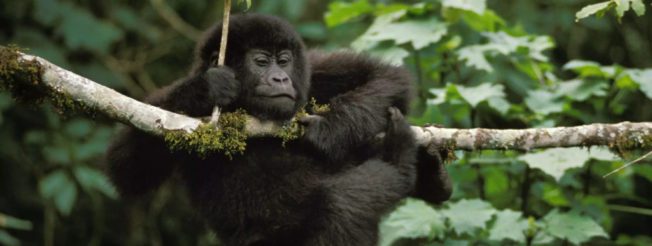rwa
World Gorilla Day 2023
In the heart of Africa, nestled among the lush, mist-covered mountains, Rwanda’s gorilla conservation success story stands as a shining example of what determination, innovation, and unwavering commitment can achieve. This small East African nation has not only protected its endangered mountain gorillas but also transformed them into a symbol of hope, resilience, and sustainable tourism. Let’s journey through Rwanda’s inspiring tale of gorilla conservation.
Rwanda’s Remarkable Gorilla Conservation Success Story
- Gorillas on the edge of extinction
- Dian Fossey’s Legacy
- Rwanda’s Transformation
- Rwanda’s Success Story


Rwanda’s Remarkable Gorilla Conservation Success Story
The Precarious Status of Mountain Gorillas
Mountain gorillas, a subspecies of eastern gorillas, have long been on the brink of extinction. Their native habitat, the Virunga Massif, spanning Rwanda, Uganda, and the Democratic Republic of Congo, has faced threats like habitat loss, poaching, and political instability.
The Dark Days: Gorillas on the Edge
During the late 20th century, mountain gorillas faced severe population decline. By the 1970s, their numbers had dwindled to a mere 250 individuals. Conservationists and researchers feared that extinction was imminent without immediate action.
Dian Fossey’s Legacy
Dian Fossey, an American primatologist, dedicated her life to studying and protecting mountain gorillas. Her groundbreaking work, depicted in the famous film “Gorillas in the Mist,” brought international attention to the species’ plight. Fossey’s tragic murder in 1985 highlighted the dangers faced by those working to save these gorillas.
Rwanda’s Transformation: A Conservation Milestone
Rwanda’s transformation from a nation scarred by civil conflict to a beacon of gorilla conservation is nothing short of remarkable. Several key factors contributed to this success story:
Collaborative Conservation Efforts
Rwanda’s government recognized the importance of conserving its natural heritage and worked closely with international organizations and local communities. The establishment of the Volcanoes National Park in 1925 marked a pivotal step toward gorilla protection.
Community Involvement
Engaging local communities in conservation efforts has been crucial. Revenue-sharing programs, where a portion of gorilla trekking permits goes to local communities, incentivize people to protect the gorillas and their habitats.
Sustainable Tourism
Rwanda pioneered responsible gorilla tourism. Carefully managed gorilla trekking experiences generate revenue for conservation while minimizing human impact on the gorillas. This approach has become a model for other countries with gorilla populations.
Robust Anti-Poaching Measures
Rwanda’s commitment to gorilla conservation includes rigorous anti-poaching efforts. Highly trained rangers patrol the park, ensuring the safety of the gorillas and visitors.
Research and Monitoring
Ongoing research helps scientists understand gorilla behavior, health, and genetics. This knowledge informs conservation strategies and enhances the gorillas’ well-being.
Rwanda’s Remarkable Gorilla Conservation Success Story
Rwanda’s gorilla conservation success story serves as an inspiration to the world. From the brink of extinction, mountain gorillas now number over 1,000 individuals, and their population continues to grow. Rwanda’s dedication to sustainable tourism, community engagement, and strong conservation policies offers valuable lessons for preserving our planet’s most endangered species.
As we celebrate World Gorilla Day and reflect on Rwanda’s achievements, we must recognize the importance of continued support for gorilla conservation. By learning from Rwanda’s success, we can ensure a future where mountain gorillas and other endangered species thrive in the wild.
